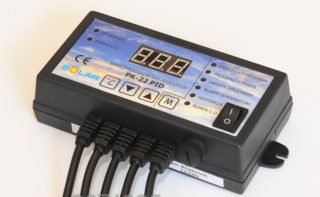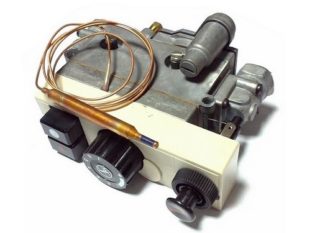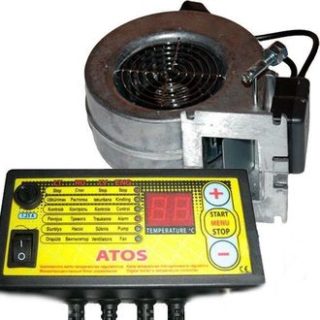Automatic control systems are installed on almost all boiler equipment. With their help, it is possible to level or completely eliminate such shortcomings of boilers as low efficiency of fuel utilization, high costs of maintenance and dependence on energy supply. This can be achieved through additional cash injections. You can install and configure a set of heating equipment yourself.
Automation for solid fuel boilers
Solid fuel boilers equipped with devices and mechanisms that partially relieve the operator’s load are considered separately. Automation for solid fuel boilers, first of all, is represented by a forced fuel supply mechanism to the combustion chamber. The indicated possibility is most often realized in units operating on pellets or granules obtained from wood waste.
Automatic fuel boiler equipment is one of the most efficient; its real efficiency sometimes reaches 80-85%, which is explained by the complete burning of the stored portions of fuel. This approach guarantees cleanliness and order during the operation of the device, as the fuel is simply poured into the hopper, from where it is fed into the chamber. The controller for solid fuel boilers controls the basic processes, including adjusting the air supply to the combustion zone and dosing of pellets loaded into the furnace.
In the presence of pellets in the receiving hopper, the unit continues to work, in their absence, it is turned off by means of an automatic machine. In addition to all the described functions, solid fuel units are equipped with a device that allows you to clean the ash pan without human intervention.
Types and advantages of automatic devices for gas boilers
Automation for a gas boiler is traditionally classified by the degree of its dependence on energy supply. According to this feature, they distinguish:
- volatile systems that operate only in the presence of electricity;
- non-volatile electronics that do not need to be connected to an electrical network.
The second option usually uses a redundant UPS. Many users prefer systems that are dependent on the power supply, as they have more functionality. The second option of powering automation for heating is relevant for situations where in a particular area there are constant power outages, and the device itself reliably works from the simplest electronics.
The advantages of automatic gas boilers as controlled units include:
- the ability to maintain the temperature in the heating circuits at a fixed level without human intervention;
- ability to work in automatic mode for a long time (up to 48 hours);
- the presence of an automatic arson system for solid and gas fuels;
- limiting operator intervention in the control of a floor or wall boiler.
It is enough for the user to set a certain temperature regime, which is constantly maintained within the premises.
An important advantage of gas-fired boilers equipped with automation is independence in critical operating conditions. In case of an emergency shutdown, do not wait for it to cool completely.
There is no need to drain the coolant, for fear of defrosting the system. Automation will perform all these operations at the command of the owner, not located within the house. Via telephone-controlled electronics, the required mode of operation of the gas boiler can be set and, if desired, optimized.
Automation for heating boilers allows you to maintain a comfortable temperature in a private house and, if necessary, change it in any direction.
Key Features
The characteristic indicators of the electronic controllers built into the boiler include:
- the ability to control the intensity of the fuel supply to the node responsible for its combustion;
- the implementation of all the protective functions provided for such systems (from overheating or freezing of pipes, stopping the pump);
- the number of management objects and the possibility of their priority choice;
- the presence of a GPS unit that allows you to control the boiler automation remotely;
- the ability to update software at regular intervals.
Modern controllers that control the operation of heating systems can be connected directly to a personal computer. This feature also characterizes them in terms of expanding functionality.
Automation principle and functionality
Before installing a solid fuel or gas boiler, it is important to understand the principle of its operation. To do this, get acquainted with its device in terms of automatic control. The safety automation of gas-fired boilers includes two main components:
- A fan mounted in the lower part of the product on the door of the air inlet (so-called “blower”) door or on an ash pan. The device is intended for forcing air to the place of fuel combustion, on the volume of which the intensity of the process depends.
- A controller or electronic control module that determines the fan speed and other system parameters.
The controller and fan are purchased as a set or separately, but only work in an interconnected pair. Most electronic modules have the ability to control the operation of the circulation pump and chimney. Some models have the option of turning them on by command from a room thermostat.
The basis of the automation is the principle of expansion of metallic substances with a gradual increase in temperature. When heated, the sensitive sensor in the system changes its initial dimensions and mechanically covers the blower, reducing the rate of fuel combustion and vice versa. Such a draft regulator is installed during the manufacture of equipment, and after adjustment allows you to maintain a user-defined mode.
Understanding the essence of the functioning of the unit allows us to formulate the main tasks of control electronics:
- ensuring the optimum temperature in the heating circuits of the system;
- control of the operating modes of the main components of the heating equipment;
- maintaining the desired temperature for heating hot water;
- the ability to turn on and off the existing equipment on command from a remote control;
- reduced consumption of solid fuel or mining, loaded and poured into the bunkers and capacities of boiler units.
When evaluating the efficiency of controlling the operation of the boiler, an energy-dependent option is preferable. With its help, it is possible to increase the functionality of the equipment used and the heating efficiency.
Popular manufacturers
Among the popular models of controllers for boiler equipment is the product ATOS + WPA 120 from the Polish manufacturer KOM-STER.It is deservedly considered one of the best automation kits for boilers of any class. ATOS controllers among other models stand out for their advanced functionality, a large number of tunable parameters and quite affordable price.
In addition to the standard set of functions, the electronic device provides:
- protection against freezing of heating system elements;
- the ability to alert about an emergency temperature drop (overheating), as well as the lack of fuel;
- LED indication of turning on the circulation pump and built-in fan;
- manual setting of parameters determined by the sequence of equipment operation cycles.
According to customer reviews, this model is characterized by high operational reliability. Its advantages are clearly shown when working together with a blower fan brand M + M WPA 120, time-tested Polish model. The set is designed to work with heating equipment with a capacity of about 25-50 kW.
Another controller model from Poland is COMFORT-ECO + NWS-100. It has the same functionality as the previous one, but the cost is even lower. Its application guarantees complete security of the equipment in operation due to the following features:
- the presence of a room thermostat and remote (street) temperature sensors;
- option for controlling the circulation pump (without hot water);
- the presence of a fuse for emergency operation.
Noteworthy is the KG Elektronik CS-18S brand controller, considered the best model in the market of electronic control products. It attracts users by the presence of a touch screen, as well as the ability to control the operating modes of all auxiliary equipment.







